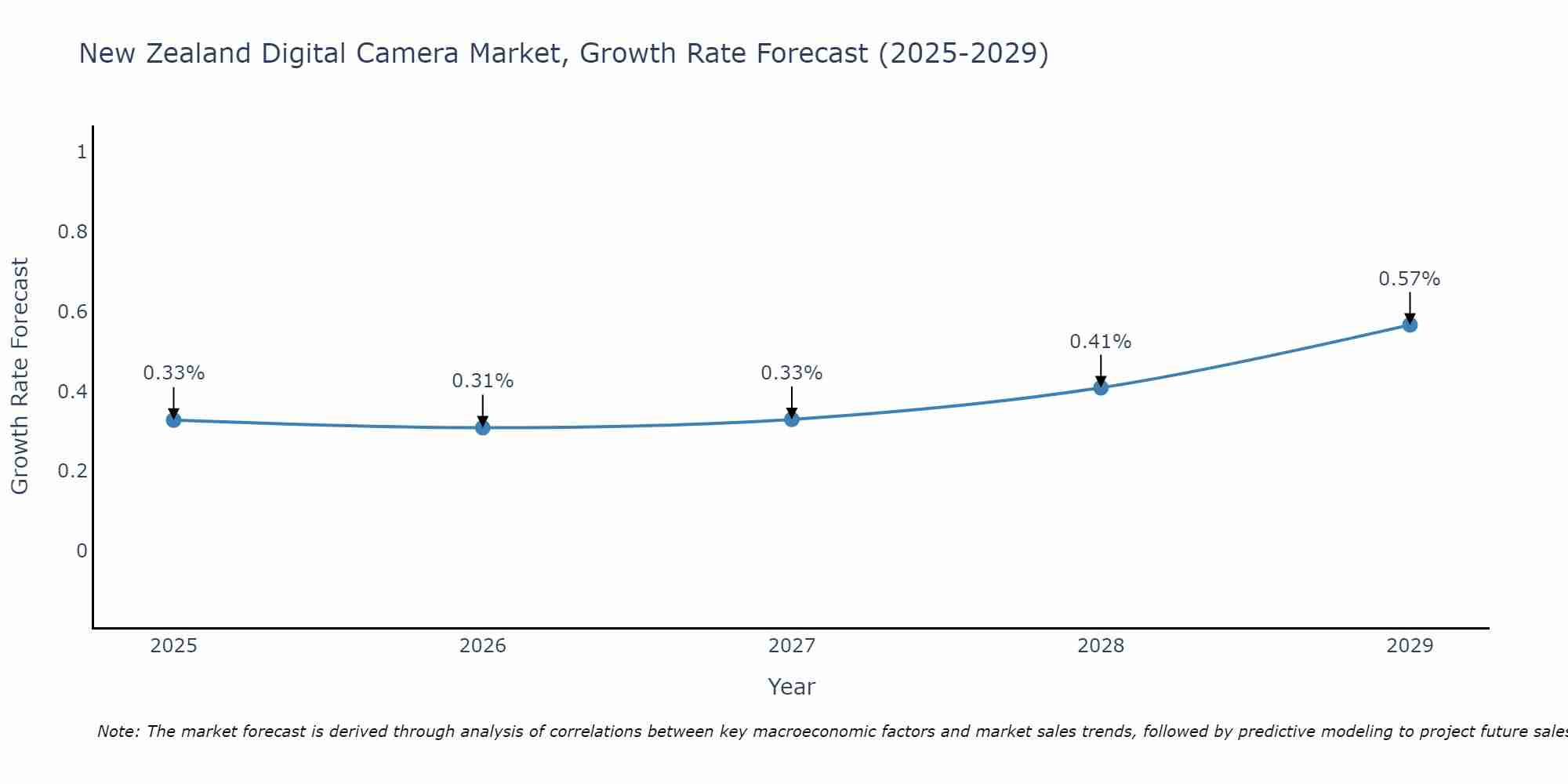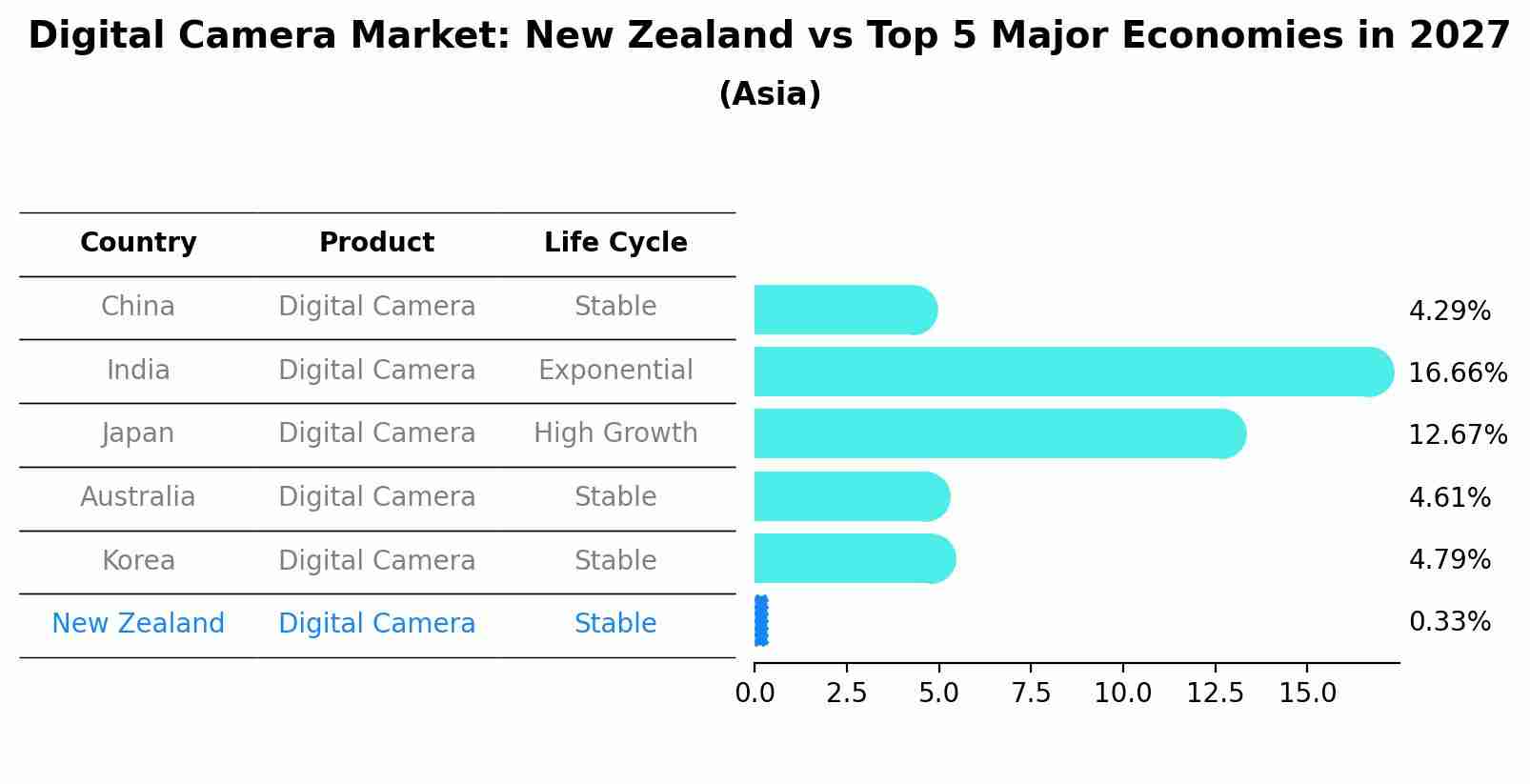New Zealand Digital Camera Market (2025-2031) | Industry, Size, Share, Forecast, Revenue, Trends, Segmentation, Companies, Value, Growth, Outlook & Analysis
| Product Code: ETC4931452 | Publication Date: Nov 2023 | Updated Date: Sep 2025 | Product Type: Market Research Report | |
| Publisher: 6Wresearch | Author: Sachin Kumar Rai | No. of Pages: 60 | No. of Figures: 30 | No. of Tables: 5 |
New Zealand Digital Camera Market Size Growth Rate
The New Zealand Digital Camera Market is projected to witness mixed growth rate patterns during 2025 to 2029. Commencing at 0.33% in 2025, growth builds up to 0.57% by 2029.

Digital Camera Market: New Zealand vs Top 5 Major Economies in 2027 (Asia)
By 2027, New Zealand's Digital Camera market is forecasted to achieve a stable growth rate of 0.33%, with China leading the Asia region, followed by India, Japan, Australia and South Korea.

New Zealand Digital Camera Market Overview
The digital camera market in New Zealand continues to evolve with the latest advancements in imaging technology. From compact point-and-shoot cameras to high-end DSLRs and mirrorless cameras, consumers have a wide range of options to choose from. Additionally, the integration of advanced features such as image stabilization and enhanced connectivity is driving demand in the market.
Drivers of the market
Advancements in digital imaging technology, coupled with the popularity of social media, photography, and content creation, drive the demand for Digital Cameras in New Zealand. Consumers seek compact, high-resolution cameras with advanced features like interchangeable lenses, image stabilization, and wireless connectivity for capturing and sharing moments, fostering market growth and innovation.
Challenges of the market
The New Zealand digital camera market is affected by the proliferation of smartphones with advanced camera capabilities. Maintaining market relevance amidst changing consumer preferences is a significant challenge for traditional digital camera manufacturers.
Government Policy of the market
The digital camera market in New Zealand is influenced by import regulations, consumer protection laws, and standards set by the Electrical Workers Registration Board (EWRB) for electrical products` safety. Regulations aim to ensure product quality and safety for consumers.
Key Highlights of the Report:
- New Zealand Digital Camera Market Outlook
- Market Size of New Zealand Digital Camera Market, 2024
- Forecast of New Zealand Digital Camera Market, 2031
- Historical Data and Forecast of New Zealand Digital Camera Revenues & Volume for the Period 2021-2031
- New Zealand Digital Camera Market Trend Evolution
- New Zealand Digital Camera Market Drivers and Challenges
- New Zealand Digital Camera Price Trends
- New Zealand Digital Camera Porter`s Five Forces
- New Zealand Digital Camera Industry Life Cycle
- Historical Data and Forecast of New Zealand Digital Camera Market Revenues & Volume By Product for the Period 2021-2031
- Historical Data and Forecast of New Zealand Digital Camera Market Revenues & Volume By Built-in Lens Camera for the Period 2021-2031
- Historical Data and Forecast of New Zealand Digital Camera Market Revenues & Volume By Interchangeable Lens Camera for the Period 2021-2031
- Historical Data and Forecast of New Zealand Digital Camera Market Revenues & Volume By DSLR for the Period 2021-2031
- Historical Data and Forecast of New Zealand Digital Camera Market Revenues & Volume By Non-reflex for the Period 2021-2031
- New Zealand Digital Camera Import Export Trade Statistics
- Market Opportunity Assessment By Product
- New Zealand Digital Camera Top Companies Market Share
- New Zealand Digital Camera Competitive Benchmarking By Technical and Operational Parameters
- New Zealand Digital Camera Company Profiles
- New Zealand Digital Camera Key Strategic Recommendations
Frequently Asked Questions About the Market Study (FAQs):
1 Executive Summary |
2 Introduction |
2.1 Key Highlights of the Report |
2.2 Report Description |
2.3 Market Scope & Segmentation |
2.4 Research Methodology |
2.5 Assumptions |
3 New Zealand Digital Camera Market Overview |
3.1 New Zealand Country Macro Economic Indicators |
3.2 New Zealand Digital Camera Market Revenues & Volume, 2021 & 2031F |
3.3 New Zealand Digital Camera Market - Industry Life Cycle |
3.4 New Zealand Digital Camera Market - Porter's Five Forces |
3.5 New Zealand Digital Camera Market Revenues & Volume Share, By Product, 2021 & 2031F |
4 New Zealand Digital Camera Market Dynamics |
4.1 Impact Analysis |
4.2 Market Drivers |
4.2.1 Increasing demand for high-quality imaging and photography |
4.2.2 Technological advancements leading to more innovative digital camera features |
4.2.3 Growing popularity of social media platforms driving the need for better quality images |
4.3 Market Restraints |
4.3.1 Market saturation with smartphones offering advanced camera capabilities |
4.3.2 High competition leading to pricing pressures |
4.3.3 Economic uncertainties impacting consumer spending on non-essential items |
5 New Zealand Digital Camera Market Trends |
6 New Zealand Digital Camera Market Segmentations |
6.1 New Zealand Digital Camera Market, By Product |
6.1.1 Overview and Analysis |
6.1.2 New Zealand Digital Camera Market Revenues & Volume, By Built-in Lens Camera, 2021-2031F |
6.1.3 New Zealand Digital Camera Market Revenues & Volume, By Interchangeable Lens Camera, 2021-2031F |
6.1.4 New Zealand Digital Camera Market Revenues & Volume, By DSLR, 2021-2031F |
6.1.5 New Zealand Digital Camera Market Revenues & Volume, By Non-reflex, 2021-2031F |
7 New Zealand Digital Camera Market Import-Export Trade Statistics |
7.1 New Zealand Digital Camera Market Export to Major Countries |
7.2 New Zealand Digital Camera Market Imports from Major Countries |
8 New Zealand Digital Camera Market Key Performance Indicators |
8.1 Percentage of households owning a digital camera |
8.2 Number of photography enthusiasts attending workshops and events |
8.3 Adoption rate of new digital camera models with advanced features |
9 New Zealand Digital Camera Market - Opportunity Assessment |
9.1 New Zealand Digital Camera Market Opportunity Assessment, By Product, 2021 & 2031F |
10 New Zealand Digital Camera Market - Competitive Landscape |
10.1 New Zealand Digital Camera Market Revenue Share, By Companies, 2024 |
10.2 New Zealand Digital Camera Market Competitive Benchmarking, By Operating and Technical Parameters |
11 Company Profiles |
12 Recommendations | 13 Disclaimer |
- Single User License$ 1,995
- Department License$ 2,400
- Site License$ 3,120
- Global License$ 3,795
Search
Thought Leadership and Analyst Meet
Our Clients
Related Reports
- Germany Breakfast Food Market (2026-2032) | Industry, Share, Growth, Size, Companies, Value, Analysis, Revenue, Trends, Forecast & Outlook
- Australia Briquette Market (2025-2031) | Growth, Size, Revenue, Forecast, Analysis, Trends, Value, Share, Industry & Companies
- Vietnam System Integrator Market (2025-2031) | Size, Companies, Analysis, Industry, Value, Forecast, Growth, Trends, Revenue & Share
- ASEAN and Thailand Brain Health Supplements Market (2025-2031) | Strategy, Consumer Insights, Analysis, Investment Trends, Opportunities, Growth, Size, Share, Industry, Revenue, Segments, Value, Segmentation, Supply, Forecast, Restraints, Outlook, Competition, Drivers, Trends, Demand, Pricing Analysis, Competitive, Strategic Insights, Companies, Challenges
- ASEAN Bearings Market (2025-2031) | Strategy, Consumer Insights, Analysis, Investment Trends, Opportunities, Growth, Size, Share, Industry, Revenue, Segments, Value, Segmentation, Supply, Forecast, Restraints, Outlook, Competition, Drivers, Trends, Demand, Pricing Analysis, Competitive, Strategic Insights, Companies, Challenges
- Europe Flooring Market (2025-2031) | Outlook, Share, Industry, Trends, Forecast, Companies, Revenue, Size, Analysis, Growth & Value
- Saudi Arabia Manlift Market (2025-2031) | Outlook, Size, Growth, Trends, Companies, Industry, Revenue, Value, Share, Forecast & Analysis
- Uganda Excavator, Crane, and Wheel Loaders Market (2025-2031) | Strategy, Consumer Insights, Analysis, Investment Trends, Opportunities, Growth, Size, Share, Industry, Revenue, Segments, Value, Segmentation, Supply, Forecast, Restraints, Outlook, Competition, Drivers, Trends, Demand, Pricing Analysis, Competitive, Strategic Insights, Companies, Challenges
- Rwanda Excavator, Crane, and Wheel Loaders Market (2025-2031) | Strategy, Consumer Insights, Analysis, Investment Trends, Opportunities, Growth, Size, Share, Industry, Revenue, Segments, Value, Segmentation, Supply, Forecast, Restraints, Outlook, Competition, Drivers, Trends, Demand, Pricing Analysis, Competitive, Strategic Insights, Companies, Challenges
- Kenya Excavator, Crane, and Wheel Loaders Market (2025-2031) | Strategy, Consumer Insights, Analysis, Investment Trends, Opportunities, Growth, Size, Share, Industry, Revenue, Segments, Value, Segmentation, Supply, Forecast, Restraints, Outlook, Competition, Drivers, Trends, Demand, Pricing Analysis, Competitive, Strategic Insights, Companies, Challenges
Industry Events and Analyst Meet
Whitepaper
- Middle East & Africa Commercial Security Market Click here to view more.
- Middle East & Africa Fire Safety Systems & Equipment Market Click here to view more.
- GCC Drone Market Click here to view more.
- Middle East Lighting Fixture Market Click here to view more.
- GCC Physical & Perimeter Security Market Click here to view more.
6WResearch In News
- Doha a strategic location for EV manufacturing hub: IPA Qatar
- Demand for luxury TVs surging in the GCC, says Samsung
- Empowering Growth: The Thriving Journey of Bangladesh’s Cable Industry
- Demand for luxury TVs surging in the GCC, says Samsung
- Video call with a traditional healer? Once unthinkable, it’s now common in South Africa
- Intelligent Buildings To Smooth GCC’s Path To Net Zero


















